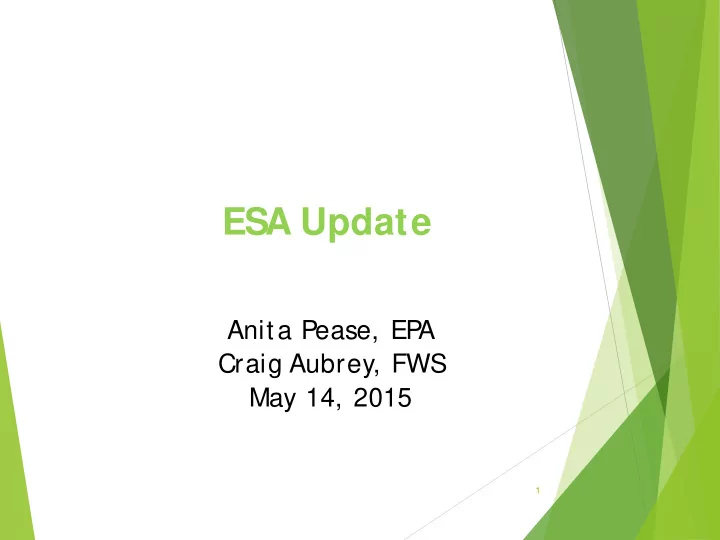

ESA Update Anita Pease, EP A Craig Aubrey, FWS May 14, 2015 1
Today’s Topics S tatus of ES A-related Activities April 2015 ES A S takeholder Meeting Challenges and Perspectives 2
National Academy of S ciences Report Released on April 30, 2013 Developed in response to a j oint request by EP A, NMFS , FWS , and US DA Recommended 3-step process that integrates ecological risk assessment methods with ES A S ection 7 consultations 3
3-Step Approach: ESA Consultation Problem and Ecological Risk Assessment formulation Exposure Response Step 1 Analysis Analysis No May Affect? Risk Characterization EPA Yes Problem [BE] formulation Exposure Response Step 2 Analysis Analysis No Likely to Adversely Affect? Risk Characterization Yes Concurrence? Yes FWS Problem formulation and Step 3 NOAA Exposure Response No Jeopardy? Analysis Analysis [BiOp] Adverse Modification? Registration Risk Characterization or No reregistration Yes of pesticide EPA decides whether and under what conditions to register pesticide 4
Interagency Process Agreements Goal: unified interagency approach with agreement on process across all phases “ S hared” agency approaches All agencies open to change in risk assessment methodologies Once vetted, day-forward and iterative approach based on real-world experience S treamlined process 5
ESA Timeline April 2013: NAS report released Three interagency workshops: August 2013, May 2014, and November 2014 Four stakeholder workshops: November 2013: Interim scientific approaches http:/ / www.epa.gov/ espp/ 2013/ nas.html April 2014: Feedback on interim approaches October 2014: Interagency presentations and more stakeholder feedback April 2015: http:/ / www.epa.gov/ espp/ 2015/ espp- workshop.html S ettlement agreements on ES A-litigation 6 Multiple stakeholder presentations
Status of Ongoing Work First national-level pesticide consultations Collaborative effort among EP A, NMFS , FWS , and US DA Consistent with interim approaches based on the NAS report recommendations The three pilot chemicals are: Chlorpyrifos Diazinon Malathion Draft Biological Evaluations (BEs) for three pilots in Fall of 2015 Final Biological Opinions (BiOps) for three pilots in December of 2017 7
April 2015 Stakeholder Workshop Update on the Problem Formulation (PF) for the three ES A pilot chemicals Geospatial data on pesticide use patterns and listed species range maps Risk hypothesis and weight-of-evidence (WOE) approach S tep 2 analysis: Aquatic analysis: shortnose sturgeon Terrestrial analysis: Kirtland’s warbler 8
April 2015 Stakeholder Workshop Update of the PF for three ES A pilots Description of the Federal Action under ES A Product labels of all pesticide products containing the pesticide being assessed S eeking label clarification of use sites that can be anywhere Pesticide Active Ingredient Information Mode and mechanism of action, fate overview and degradates of concern Conceptual models Analysis plan S tep 1 – “ May affect” or “ no effect” – based on co-occurrence of species range with pesticide use S tep 2 – NLAA or LAA 9
April 2015 Stakeholder Workshop Geospatial data Needed for S teps 1-3 of the analysis Pesticide Use S ites: Agricultural uses: Cropland Data Layer (CDL) and National Agricultural S tatistic S ervice (NAS S ) census levels Non-ag uses: forestry, nurseries, mosquitocides Listed S pecies Range Maps: NMFS species provided to EP A (~100 species) FWS using phased approach to refine and deliver data 10
April 2015 Stakeholder Workshop Risk Hypothesis (RH) and WOE Approach RH = is it likely that fitness of an individual of a listed species and/ or the primary and biological features (PBFs) of designated critical habitat will be adversely affected by pesticide x according to registered labels? Various lines of evidence are assigned weights based on confidence in data using criteria Exposure data: relevance and robustness Effects data: biological relevance, species surrogacy, and robustness Compare exposure concentration data with effects data to establish overlap Interagency teams are currently developing the WOE process 11 Approach to be applied and revised based on lessons learned from the pilot BEs
Challenges and Perspectives Aquatic modeling ~2000 - 8000 modeling runs per chemical Terrestrial modeling Need to account for 3 different sets of units (mg/ kg diet, mg/ kg BW, and lbs a.i./ A) Need to integrate existing terrestrial tools (T-REX, T- HERPs, AgDrift, and TerrPlant) Number of LAA/ NLAA calls - 1,850 listed species, approx. 800 of which have designated critical habitat (CH) 12
Challenges and Perspectives Each Agency implements its statute, regulation, and policies This is not a “ culture” Each organization is expected and required to carry out their mandates NAS report provided the roadmap Gray areas require interpretation and j udgement It’s a lot of work It’s not one and done; additional analyses will be routine Conclusions will change 13
Questions? 14
Recommend
More recommend